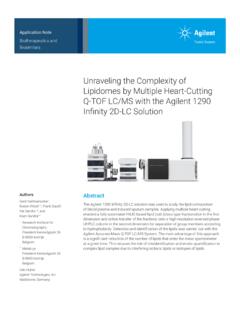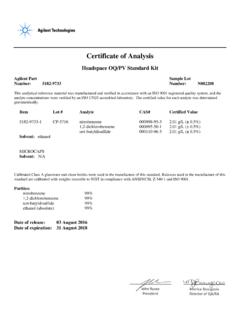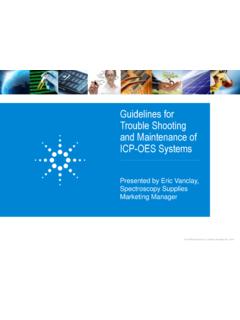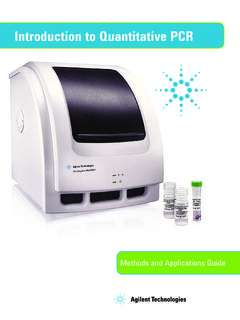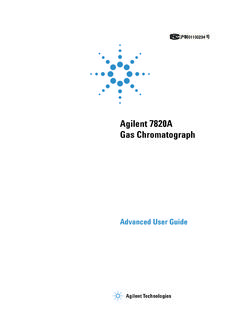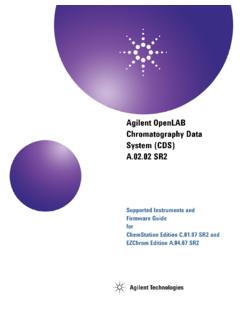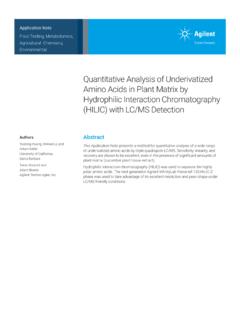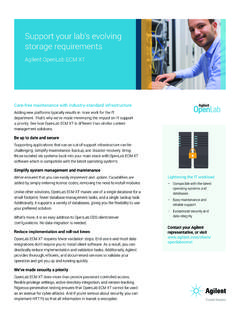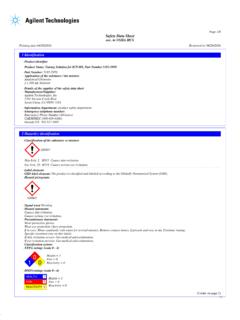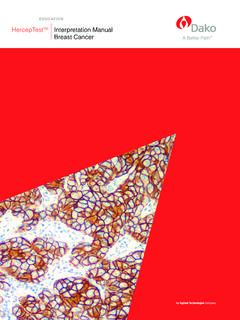Transcription of VOLUME 17 ISSUE 3 PAGE 1 DAN SPISAK, PRODUCT ... - Agilent
1 1 Agilent TECHNOLOGIESPRACTICAL SOLUTIONS NEWSLETTERVOLUME 17 ISSUE 3 DAN SPISAK, PRODUCT manager , dissolution SYSTEMSAUTOMATION optimization FOR UV-VIS AND LC dissolution SAMPLE ANALYSIST here s no doubt that automating your dissolution testing makes life easier. In fact, once the system validation is performed for your PRODUCT (s), the right solution allows you to complete other tasks without having to worry about taking that next sample. The benefits of automation , however, aren t just about productivity; having the correct instrumentation in place also brings reproducibility advantages. By having automated components perform the sample removal, filtration, and collection, analyst variability is eliminated, creating a consistent, repeatable workflow for each 1 automation optimization for UV-Vis and LC dissolution Sample Analysis PAGE 3 Progress Report: Stay Current with 708-DS and 850-DS Firmware UpdatesPAGE 4 dissolution Sampling Location: Meet the Latest CP RequirementsPAGE 5 USP Pharmacopeial Forum Update: <1236> Solubility MeasurementsPAGE 6 Questions You AskedPAGE 7 Agilent Sites and ServicesAGILENT TECHNOLOGIES PRACTICAL SOLUTIONS NEWSLETTERVOLUME 17 ISSUE 32 For many years, online UV- dissolution systems have led the way when it comes to simplifying both the dissolution test as well as the UV-Vis analysis and data processing.
2 The Agilent Cary 60 and Cary 8454 UV-Vis spectrophotometers both provide complete solutions that automate this entire process. But what about products that require a different type of analysis? Does your online system now sit idle and become useless for these methods? Not anymore. Recent releases of software that power Agilent s UV- dissolution systems now fully accommodate the 850-DS Sampling Station. This is important because the integrated design of the 850-DS comprising a pump, optional filter module, and sample tray allows for movement of samples to the spectrophotometer for UV-Vis analysis or collection of samples into vials for subsequent LC injection. This means that the same instrumentation may be used for all your products, irrespective of the analytical technique required. The addition of the 850-DS filter module provides the or m filtration often necessary for sample cleanup prior to injection.
3 Not only that, but now all your dissolution methods and test data can be stored in a single, centralized database. Each system comprising a 708-DS dissolution Apparatus, 850-DS Sampling Station, Cary 60 or Cary 8454 UV-Vis spectrophotometer, and the respective software package has its own distinct advantage depending on your specific method requirements, preferences, or Cary 60 system utilizes Cary WinUV dissolution software to control the dissolution system , data capture, and report processing. Compliance is governed by the Spectroscopy Database Administrator (SDA) and Spectroscopy Configuration manager (SCM) to ensure that the necessary 21 CFR Part 11 requirements are new version of UV-ChemStation software powers the Cary 8454 system and provides the instrument control, method management, and reporting. Depending on your specific environment, compliance is managed by either the latest version of Security Pack software or can be integrated with Agilent s OpenLab Enterprise Content manager software.
4 Both versions of software have now been validated for use in a Microsoft Windows 10 environment as well. Ultimately, your own internal requirements should determine what level or type of automation is right for your dissolution laboratory. These UV- dissolution systems deliver all the advantages of online UV-Vis and offline LC sample collection with an organized, compliant software package at their core. Either way, Agilent has you covered. For more information on the dissolution , spectroscopy, HPLC, or software solutions available, please contact your Agilent representative or visit Cary 8454 Cary 60 Closed Loop SamplingYe sYe sPath Lengths (mm)1, 2, 5, 101, 2, 5, 10 Automated Dosage DeliveryYe sYe sAutomated SamplingYe sYe sTemperature MonitoringYe sYe sIn-situ Fiber Optic MeasurementNoYe sSample m or m or mSample ArchivalYe sYe sNumber of Apparatus11 or 2 Online UV- dissolution system details with 850-DS sampling station and filter moduleAGILENT TECHNOLOGIES PRACTICAL SOLUTIONS NEWSLETTERVOLUME 17 ISSUE 33 DAN SPISAK, PRODUCT manager , dissolution SYSTEMSPROGRESS REPORT: STAY CURRENT WITH 708-DS AND 850-DS FIRMWARE UPDATES In keeping with our commitment to continuous improvement, Agilent is announcing updates to the firmware versions of both the 708-DS dissolution Apparatus and 850-DS Sampling Station.
5 The development and internal evaluation of these updates are now complete. All new units will be delivered with this firmware; existing units in the field may be upgraded at the user s discretion. We recommend coordinating an upgrade with Agilent s service team at the time of a periodic qualification or system maintenance. The firmware updates add the following functionality:708-DS version Individual usernames/passwords added for access control Improved alarms for sample point notifications Additional graphics for user when performing sequential manual sampling Vessel temp probes enabled to measure temperatures down to 5 C C850-DS version Individual usernames/passwords added for access control User levels customization now available by system administrator VOLUME calibration guide and storage of calibration history added Automated rinsing of internal reservoirs included as system clean optionYour feedback is appreciatedAgilent is always looking for ways to make your dissolution testing easier.
6 In fact, many of the improvements listed above came from our customers. If you have a suggestion or idea, let us know! We d love to hear from you. Feel free to contact us at any time at Please put Feedback in the subject of your message so we can filter these responses appropriately. You can also use the dissolution Hotline for any dissolution -related questions. Agilent TECHNOLOGIES PRACTICAL SOLUTIONS NEWSLETTERVOLUME 17 ISSUE 34 ALLAN LITTLE, DIRECTOR OF MARKETING, dissolution SYSTEMSDISSOLUTION SAMPLING LOCATION: MEET THE LATEST CP REQUIREMENTS The internationally accepted current and historical position for withdrawing dissolution samples is from a zone midway between the surface of the dissolution Medium and the top of the rotating basket or blade, not less than 1 cm from the vessel wall. (USP <711>) A recent change in the Chinese Pharmacopeia (CP) 2015 specifies this distance at 10 mm from the wall of the vessel.
7 While this change may appear minor, it could have an impact on dissolution test results for products tested per previous CP or other international pharmacopeias. It will be critical for multinational companies to ensure their dissolution methods specify the sampling location. Fortunately, the Agilent 708-DS dissolution Apparatus is designed to accommodate this change. Simply repositioning the sampling cannula on the sampling manifold ensures that the samples are taken at the properly specified location. A new evaporation cover is available for the 708-DS that has a rubber gasket through which the sample and return cannula pass. Simply rotate this removable gasket 180 degrees to switch between the USP-prescribed location or the new CP requirement. All new 708-DS instruments include the adjustable manifold and the newly designed evaporation covers. If you have an earlier 708-DS and would like to order a new manifold with the CP sampling location or new evaporation covers with USP/CP sampling capabilities, use the following catalog numbers.
8 Please note that both the updated manifold and covers are required to achieve sampling from the CP NumberQuantity708-DS evaporation cover, standard, for CP/USP samplingK1005-052256 or 8 AND one (1) of the following:708-DS manifold, sampling only, 8-position, 1LK1001-011721708-DS manifold, sampling only, 8-position, 2LK1001-011761708-DS manifold, sampling/temperature, 8-position, 1LK1001-011841708-DS manifold, sampling/temperature, 8-position, 2LK1001-011881 Agilent TECHNOLOGIES PRACTICAL SOLUTIONS NEWSLETTERVOLUME 17 ISSUE 35for determining apparent solubility (potentiometric titration, turbidity measurements, and miniaturized screening), such methods are not considered suitable alternatives for true equilibrium solubility determined by the shake-flask method. The shake-flask method contained in the proposed chapter describes in detail the sample preparation, experimental conditions for equilibration of the solution, analysis of the solution, and reporting solubility final sections include bio-relevant media.
9 The section on human media primarily covers human fed and fasted states for simulated gastric and intestinal fluids along with simulated colonic fluid. In veterinary medicine, however, solubility of API is the key to understanding the bioavailability of the drug over typical dissolution and drug-release testing. This is because it would be difficult to conduct drug-release testing for the diverse and complex GI conditions of the world's animal species. Several simulated fluids are contained for veterinary products, however, representing canine gastric and intestinal fasted state, as well as bovine gastric media representing a variety of pH levels and the presence or absence of short-chain fatty acids. Although the comment period for this new chapter expired on May 31, 2017, it should appear soon as an official informational chapter in the USP based on the comments received. BRYAN CRIST, SCIENTIFIC AFFAIRS MANAGERUSP PHARMACOPEIAL FORUM UPDATE: <1236> SOLUBILITY MEASUREMENTS The proposed new chapter "Solubility" published in the USP Pharmacopeial Forum 43 edition, VOLUME 2 in March of 2017 provides greater understanding of thermodynamic equilibrium.
10 It covers methods for estimating aqueous solubility, factors that affect solubility and solubility measurements, experimental methods for determining equilibrium solubility, methods for determining apparent solubility, and suggested bio-relevant media for conducting the a lengthy thermodynamic discussion, the chapter reveals the importance of evaluating the solubility of an API with a good understanding of the three factors that affect the accuracy of solubility testing: Physicochemical properties: surface area, particle size, and crystallinity or amorphism Media properties: pH, polarity, surface tension, surfactants, co-solvents, and salts Measurement properties: temperature, time, and agitation methodWith an understanding of these factors, the primary means of determining equilibrium solubility rests with the shake-flask method, which has been widely used for at least 40 years and is considered to be the most reliable method for determining solubility.
